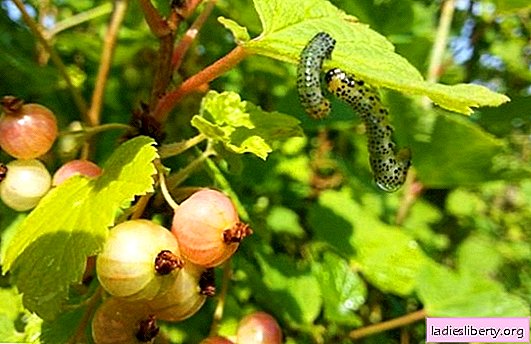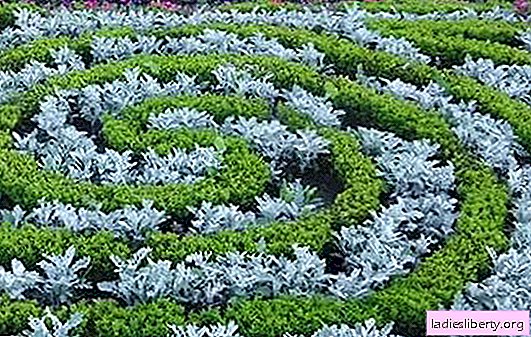
Currant is a fragrant berry bush that caterpillars and other parasites are very fond of.
If you notice in your garden that the leaves of the currant are curled, reddened or holes have appeared on them, you need to urgently take measures against the caterpillars on the currant, otherwise the bush cannot be saved.
Let's look at what types of caterpillars can eat currants.
Currant leaf caterpillar

As you know, a caterpillar is a future butterfly that lays its larvae on the leaves of fruit trees and shrubs. Leafworm most often can be seen in the northwestern part of Russia. In 4 weeks, a butterfly can lay about 150 eggs - future caterpillars. Caterpillars have a brown tint with a black head, rather large sizes.
Why are caterpillar caterpillars dangerous for currants? The fact is that they eat leaves, twisting them into a tube, after which you can see that the damaged leaf is in a web. To gain weight, leafworm caterpillars eat leaves along the edges, as well as the buds. They do not disdain the fruits of the bush. All winter, these pests are in the ground under a bush of currant, twisting into dry leaves. For this reason, in the autumn it is important to conduct surface treatment of the bush.
The fight against them should begin immediately. For this, experienced gardeners use not only folk methods, but also insecticides, as well as chemicals.
Gooseberry caterpillar on currant

From the name it is clear that this pest is eaten by gooseberries, but red and white currants also do not bypass. This caterpillar almost completely destroys the leaves of the bush.
The caterpillar of the gluttonous moth is rather large (about 4 cm), the color is gray with yellow stripes and black spots.
In the second half of summer, a moth butterfly lays eggs on the inside of the leaf. By autumn, the caterpillar is braided with cobwebs and snoozes with opal foliage all winter. In the spring, an active zhor of currant begins.
Currant glass caterpillar

If you cut a branch of currant, you can see that its entire core is eaten. This sign indicates that a currant glass-box has been planted on the bush - a highly invincible pest. This caterpillar is very difficult to bring out, since it spends all its time inside the shoot, so it is difficult to get it even with chemical preparations.
The glass-butterfly is reminiscent of a wasp. It has narrow wings with orange veins. In late May or early July, the insect begins to lay eggs in cracks in the cortex or near the kidneys. After 2 weeks, her offspring appears. The young caterpillars of the vitreous crawl into the shoots and feed on the core, gradually making their way lower and lower to the root. Currant branches abruptly begin to dry out. Remember that in the first place, such branches need to be cut and burned.
Yes, this caterpillar is difficult to overcome, but nevertheless measures exist, which we will talk about a little lower.
Measures to control the currant glass caterpillar
First of all, let's look at how to deal with the glass. You can’t sit idly by, as you destroy the whole bush. It can completely destroy them and fail, but to reduce the number to a minimum - it is possible.
So, we proceed:
1. When the caterpillar goes into the pupal stage (May-June), it leaves its shelter - the stem. At this time, you often need to loosen the soil under the bush, mixing it with tobacco dust and ash.
2. In addition to tobacco and ash, to get rid of the pupae, the soil is sprinkled with a mixture of mustard, black pepper and ash (3 tablespoons of the mixture on a bush).
3. As soon as you notice at least slightly affected branches - immediately cut and do not spare (do not forget to burn them).
4. If the glass-box hit the whole bush, it must be cut completely to the base. This year currants can not be helped. When young shoots begin to grow from the roots, your task is to carry out preventive measures.
Once you harvest, you can use chemicals. Most commonly used:
• "The spark of gold." 5 ml of the drug are taken per 10 liters of water and in early spring to process the blossoming leaves, hoping that 1.5 buckets will go to the bush.
• "Fitoverm". 2 ml of the drug are taken per 1 liter of water.
• "Akarin." For 1 liter of water, 2 ml of the drug.
• "Bitoxibacillin." For 10 liters of water, 100 grams of the drug.
Use as well as Spark. However, the difficulty will be to choose the right time for the transformation of the pupae. Do not miss this time.
After the crop is harvested, it is possible to process the bush of currant karbofosom (10%). To do this, take 75 g of the drug per 10 liters of water. Spray the bushes no more than twice.
How to destroy caterpillars on currant folk methods and not only
If you notice that the currant bush is withering, wilting, and the leaves have lost their shape, immediately proceed with pest control.
Top 10 currant track disposal tips:
1. An effective method is garlic to be planted near the bush. The pungent odor will scare away pests. A sharp odor is also possessed by: yarrow, chamomile, wormwood, marigolds.
2. Purchase tobacco dust in gardening stores and loosen the soil in early summer by adding the preparation.
3. A decoction of celandine. It is harmful to many pests of currants, especially caterpillars do not like it. Prepare the broth, let it stand and spray the bush (1-2 times a week).
4. Besides the fact that garlic can be planted near the bush, it is possible to prepare an excellent preparation against caterpillars on currants from it. To do this, take 150 g of garlic cloves, chop them and pour a liter of barely warm water. For 5 days, put the infusion in a dark place (basement). Before you start spraying, reduce the concentration (add water, 1 liter will be needed for every 10 ml).
5. Pine or spruce needles (about 1 cup) need to be insisted for a week. Before spraying, dilute the infusion 1/10.
6. Dilute household soap (30-40 g) diluted with a liter of water (warm). In early June, spray the bushes.
7. Grind the tops and leaves of the tomato so that they release their pungent smell (you need 1 kg). Pour 10 liters of boiling water and boil for 30-35 minutes. Add 40-50 g of laundry soap. Spray the foliage.
8. Finely chop the pods of hot pepper (100 g will be enough). Boil for 1 hour in a liter of water, let it brew for 2-3 days. Filter the infusion and dilute with water (100 g of solution per 10 liters of water). Add laundry soap and start spraying the currant bush.
9. Take 50-60 g of dry mustard and fill it with hot water (2 liters of water will be needed). 3 days, let the solution brew and dilute with another three liters of water.
10. Chop two onions. Pour a liter of water and let stand for several hours (best to make an infusion for the night).
Of the chemicals, gardeners often use Lepidocide, which needs to spray the bush three weeks before picking berries. It is possible to spray the affected currant bushes, both before flowering and after. In addition, such drugs as Actellik, Spark, Decis, Zolon, Karate, Metafox, Chlorophos, Bitoxibacillin are popular.











